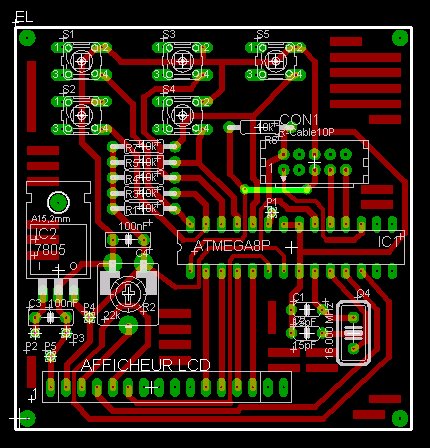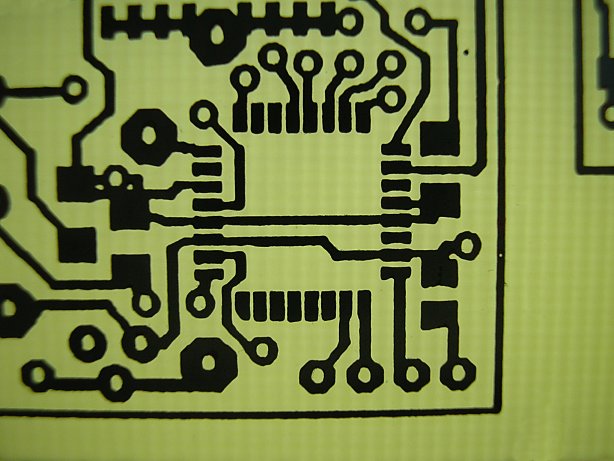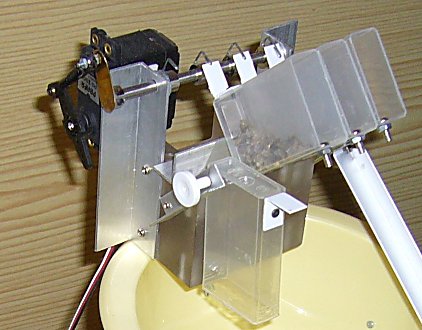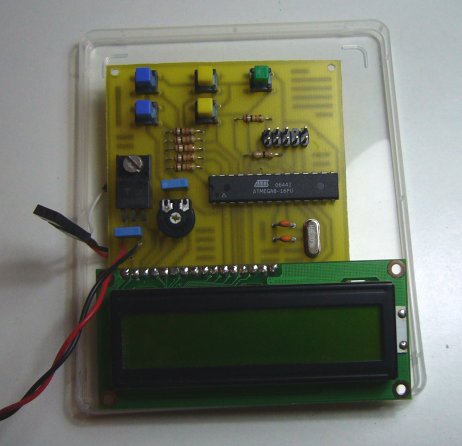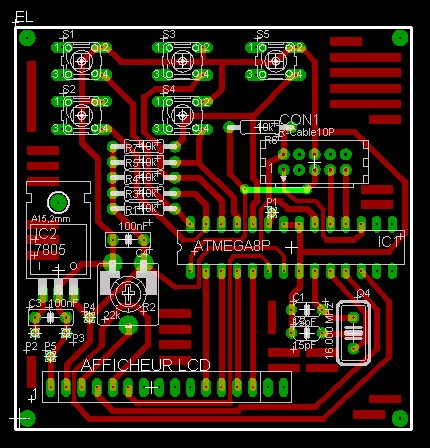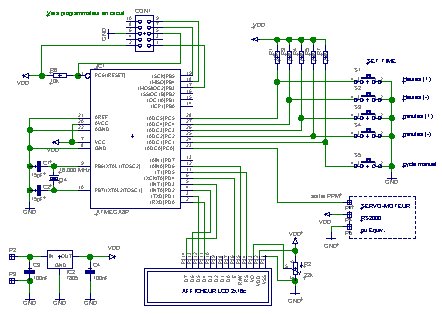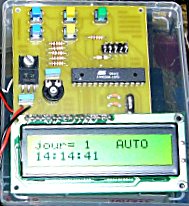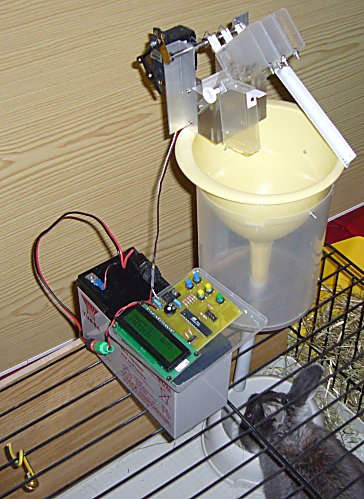program distri_graines;
{$NOSHADOW}
{ $W+ Warnings} {Warnings off}
Device = mega8, VCC = 5;
Import SysTick, LCDport, RTclock, ServoPort;
From System Import;
From RTclock Import RTCtimer, RTCalarm;
Define
ProcClock = 16000000; {Hertz}
SysTick = 10, Timer2; {msec} // ATTENTION: UTILISE LE Timer2 pour l'horloge RTC
StackSize = 100, iData; // remarque: le prog utilise 44 bytes sur les 100 allou�s (voir affi en runtime)
FrameSize = $0020, iData;
LCDport = PortD;
LCDtype = 44780;
LCDrows = 2; {rows}
LCDcolumns = 16; {columns per line}
RTclock = iData, DateTime; {Time, DateTime}
RTCsource = SysTick {, adj}; { adj = +/-100}
RTCtimer = 4;
// SysTick = 10; {msec}
// StackSize = $0020, iData;
// FrameSize = $0010, iData;
ServoPort = PortC, 0, iData; {use Portx, startbit n, RAMpage}
ServoChans = 1, positive; {channel count, pulse polarity}
ServoNeutral = 2.0, Timer1; {msec neutral pulse width, Timer used}
Define_usr
bouton_inc_h = %00100000;
bouton_dec_h = %00010000;
bouton_inc_mn = %00001000;
bouton_dec_mn = %00000100;
bouton_manuel = %00000010;
Implementation
{$IDATA}
{--------------------------------------------------------------}
{ Type Declarations }
type
tWeekDays = (Sunday, Monday, Tuesday, Wednesday, Thursday, Friday, Saturday);
tWeekDArr = array[tWeekDays] of string[10];
{--------------------------------------------------------------}
{ Const Declarations }
const
cWeekDArr : tWeekDArr = ('Dimanche',
'Lundi',
'Mardi',
'Mercredi',
'Jeudi',
'Vendredi',
'Samedi');
p1 : integer = 90;
p2 : integer = 60;
p3 : integer = 30;
p4 : integer = 0;
p5 : integer = -30;
{--------------------------------------------------------------}
{ Var Declarations }
{$IDATA}
var
delay : SysTimer8;
ticked : boolean;
timeout : boolean;
timeout1 : boolean;
alarm : boolean;
bool : boolean;
// i, j : byte;
j1, cyc1 : byte;
h1, m1, s1 : byte;
stk1 : word;
{--------------------------------------------------------------}
{ functions }
procedure init_ports; // ports perso
begin
ddrc:= ddrc and %11000001; // 5 entr�es pour les boutons
end;
procedure RTCtimer(chan : byte); // CallBack from RTCtimer
begin
{
for i:= 0 to 10 do
inc(j);
endfor;
if chan = 0 then
timeout:= true;
endif;
}
end;
procedure RTCalarm; // CallBack from RTCalarm
begin
alarm:= true;
end;
procedure RTCtickSecond; // CallBack from RTClock
begin
ticked:= true;
end;
procedure RTCtickMinute; // CallBack from RTClock
begin
cyc1:=0; // mode auto
end;
procedure RTCtickHour; // CallBack from RTClock
begin
end;
procedure MAJ_LCD;
begin
// Write(LCDout, ' ' + cWeekDArr[tWeekDays(RTCgetWeekDay)]);
LCDxy(0, 0);
LCDclrEol;
// date
LCDxy(0, 0);
Write(LCDout, 'jour=' + ByteToStr(j1 : 2 : ' ') );
LCDxy(10, 0);
if cyc1=0 then Write(LCDout, 'AUTO');
else Write(LCDout, 'manu');
endif;
{ test et affiche la pile (stack) en runtime
stk1:= GetStackFree;
LCDxy(8, 0);
Write(LCDout, 'stack=' + IntToStr(stk1 : 2 : '0') );
}
LCDclrEol;
// Write(LCDout, ByteToStr(RTCgetDay : 2 : '0') + '.');
// Write(LCDout, ByteToStr(RTCgetMonth : 2 : '0') + '.');
// Write(LCDout, '20' + ByteToStr(RTCgetYear : 2 : '0') + ' ');
// time
LCDxy(0, 1);
Write(LCDout, ByteToStr(RTCgetHour : 2 : '0') + ':');
Write(LCDout, ByteToStr(RTCgetMinute : 2 : '0') + ':');
Write(LCDout, ByteToStr(RTCgetSecond : 2 : '0'));
end;
{--------------------------------------------------------------}
{ Main Program }
{$IDATA}
begin
init_ports;
j1:= 1;
cyc1:=0; //mode auto
RTCsetSecond(0);
RTCsetMinute(0);
RTCsetHour(0);
RTCsetDay(21);
RTCsetWeekDay(02);
RTCsetMonth(08);
RTCsetYear(07);
// LCDCharSet(#0, $0E, $1F, $04, $0E, $11, $1D, $15, $0E);
// LCDCharSet(#1, $00, $0E, $15, $17, $11, $0E, $00, $00);
LCDclr; { clear display }
LCDcursor(false, false); { display on, cursor off & no blink }
// Write(LCDout, ' '+#0+' E-LAB RTC Demo '+#1);
ticked:= true;
{
RTCalarm_Time(00, 01, 25); // 00:01:25
RTCalarm_Date(01, 01, 01); // 01.01.2001
RTCalarm_Start(2); // 0 = stop, 1 = time, 2 = date+time
RTCtimer_Load(0, 15);
RTCtimer_Start(0);
RTCtimer_Load(1, 10);
RTCtimer_Start(1);
}
EnableInts;
SetServoChan(0, p1);
loop
if ticked then
ticked:= false;
MAJ_LCD;
mdelay(100);
h1:= RTCgetHour;
m1:= RTCgetMinute;
s1:= RTCgetSecond;
if (h1 = 23 ) and (m1 = 59) and (s1 = 59 )then j1:= j1 + 1; endif;
if (j1 = 1) and (h1 = 18 ) and (m1 = 0) then SetServoChan(0, p2); endif;
if (j1 = 2) and (h1 = 6 ) and (m1 = 0) then SetServoChan(0, p3); endif;
if (j1 = 2) and (h1 = 18 ) and (m1 = 0) then SetServoChan(0, p4); endif;
if (j1 = 3) and (h1 = 6 ) and (m1 = 0) then SetServoChan(0, p5); endif;
endif;
// SET TIME
if (PinC and bouton_inc_mn ) = 0 then
disableInts;
RTCsetSecond(0);
RTCsetMinute(RTCgetMinute + 1);
EnableInts;
MAJ_LCD;
while (PinC and bouton_inc_mn ) = 0 do mdelay(10); endwhile; // wait relache + anti-rebond
j1:= 1;
endif;
if (PinC and bouton_dec_mn ) = 0 then
disableInts;
RTCsetSecond(0);
RTCsetMinute(RTCgetMinute - 1);
EnableInts;
MAJ_LCD;
while (PinC and bouton_dec_mn ) = 0 do mdelay(10); endwhile; // wait relache + anti-rebond
j1:= 1;
endif;
if (PinC and bouton_inc_h ) = 0 then
disableInts;
RTCsetSecond(0);
RTCsetHour(RTCgetHour + 1);
EnableInts;
MAJ_LCD;
while (PinC and bouton_inc_h ) = 0 do mdelay(10); endwhile; // wait relache + anti-rebond
j1:= 1;
endif;
if (PinC and bouton_dec_h ) = 0 then
disableInts;
RTCsetSecond(0);
RTCsetHour(RTCgetHour - 1);
EnableInts;
MAJ_LCD;
while (PinC and bouton_dec_h ) = 0 do mdelay(10); endwhile; // wait relache + anti-rebond
j1:= 1;
endif;
if (PinC and bouton_manuel ) = 0 then
cyc1:=cyc1+1;
if cyc1>4 then SetServoChan(0, p1); cyc1:=0; endif;
case cyc1 of
0: nop; |
1: SetServoChan(0, p2); |
2: SetServoChan(0, p3); |
3: SetServoChan(0, p4); |
4: SetServoChan(0, p5); |
endcase;
while (PinC and bouton_manuel ) = 0 do mdelay(10); endwhile; // wait relache + anti-rebond
j1:= 1;
endif;
endloop;
RTCtimer_Stop(0);
end distri_graines.
